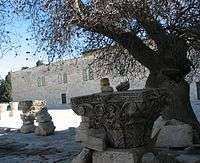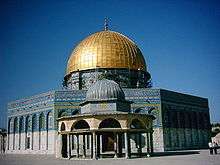Islamic Museum, Jerusalem


The Islamic Museum is a museum on the Temple Mount in the Old City section of Jerusalem. On display are exhibits from ten periods of Islamic history encompassing several Muslim regions. The museum is located adjacent to al-Aqsa Mosque.
History
The building was originally constructed by the Knights Templar, who used it as an annex to their headquarters established at the former Al-Aqsa Mosque. Following the Muslim reconquest of Jerusalem, the mosque was restored in 1194 AD.[1] The annex building served an assembly hall for the Fakhr al-Din Mohammad School, a madrasa built by al-Mansur Qalawun in 1282 CE, during the Mamluk era.[2] The museum was established by the Supreme Muslim Council in 1923. Shadia Yousef Touqan was the head planner of the site.[2] Khader Salameh is the head curator of the museum.[3]
Exhibits
The Islamic Museum displays large copper soup kettles used in the Haseki Sultan Imaret, a soup kitchen, built through a donation by Hürrem Sultan, the wife of Suleiman the Magnificent, dating back to the 16th century, as well as stained glass windows, wooden panels, ceramic tiles and iron doors from the reign of Suleiman the Magnificent. Also on display are a cannon used to announce the breaking of Ramadan, a large collection of weapons, a large wax tree trunk, the charred remains of a minbar built by Nur ad-Din Zangi in the 1170s and destroyed by an Australian tourist in 1969, and the blood-stained clothing of 17 Palestinians killed in the rioting on the Temple Mount in 1990.[3]
Qur'an manuscripts
The museum has 600 copies of the Qur'an donated to the al-Aqsa Mosque during the Umayyad, Abbasid, Fatimid, Ayyubid, Mamluk, Ottoman eras by caliphs, sultans, emirs, ulama and private individuals. Each differ in size, calligraphy and ornamentation. One is a hand-written Qur'an whose transcription is attributed to the great-great grandson of Muhammad. Another is written in Kufic script dating back to the 8th-9th century. A 30-part Moroccan Rab’ah was bequeathed by Sultan Abu al-Hasan al-Marini of Morocco, the only manuscript remaining from three collections that the sultan dispatched to the mosques of the three holy cities in Islam — Mecca, Medina and Jerusalem. In addition, there is a very large Qur'an measuring 100 by 90 centimetres (3.3 ft × 3.0 ft), dating back to the 14th century.[3]
See also
- Museum of Islamic Art, Cairo (Egypt)
References
- ↑ http://www.discoverislamicart.org/database_item.php?id=monument;ISL;pa;Mon01;2;en
- 1 2 Al-Aqsa Library and Islamic Museum Archenet Digital Library.
- 1 2 3 The Islamic Museum Jerusalemites
Coordinates: 31°46′33.87″N 35°14′05.32″E / 31.7760750°N 35.2348111°E
